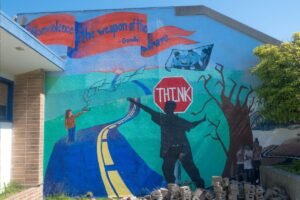
This article concludes NPQ’s series, The Vision for Black Lives: An Economic Justice Agenda. Co-produced with the Movement for Black Lives (M4BL), this series examines the many ways that M4BL and its allies are seeking to address the economic policy challenges that lie at the intersection of the struggle for racial and economic justice.
The myth of American meritocracy is not merely an occasional story; it is upheld daily by social systems, structures, and cultural narratives.One of the most deeply held and dangerous myths of our time is of American meritocracy. The false belief that a person can leverage hard work and talent to pull themselves and their family out of poverty should they only try is a pervasive story that has shaped our culture and laws.
In truth, both multigenerational wealth and poverty depend on a byzantine system of laws and policies that favor the status quo—and uphold centuries of racial discrimination.
The myth of American meritocracy is not merely an occasional story; it is upheld daily by social systems, structures, and cultural narratives about who works hard and who is lazy. These racist stories then shape our policies for years and years. Nowhere is this more evident than in the construction and decimation of the social safety net.
To change this story, to arrive at a system that centers people of color’s ability to live and work with dignity, one that acknowledges the perpetuation of structural inequality, we must first understand how we got here.
A Brief History of US Welfare
Welfare was first established in the United States by Illinois reformers in the early 1900s as a cash payment program for poor (almost exclusively White) widows who could not raise their children without help once their husbands died. If they worked, they were seen as unfit mothers and had their children taken from them. This led to state and local welfare programs, and ultimately, the Aid to Dependent Children program was launched during the Great Depression.
The US social safety net consists of Social Security, Medicare, Medicaid, unemployment insurance, and welfare programs. If payments are automatic and “by right” (as with Social Security and Medicare), they are often called “entitlement” programs.
In 1935, the Social Security Act, introduced by the administration of President Franklin Delano Roosevelt, established an idea that expressed the value that (some) Americans deserve a government that will not allow them to slide into poverty if they fall on hard times, become ill, and/or age out of the workforce. Contained within it were two different kinds of policies.
One was the Social Security pension program (which also covers disabled workers) that we know today. But also included was what became known as welfare. Originally called the Aid to Dependent Children program, it was subsequently renamed the Aid to Families with Dependent Children in 1962.
Behind these programs was the idea that a rising tide, meaning a growing US economy and improved quality of life for all, would lift all boats. In the words of President John Kennedy, welfare payments should be directed “toward prevention and rehabilitation.”
That’s not what happened, of course. Black Americans especially have faced pervasive discrimination in education, the workforce, and the ability to build wealth through property ownership. For nearly 70 years, Black people have had twice the unemployment rate of White people in the United States—even when the economy is strong. During tough economic times, Black unemployment is in the double digits, with some metropolitan areas reaching above 20 percent.
Federal programs failed to address the longstanding structural and cultural harms that prevented Black people from upending generational poverty and disenfranchisement. For example, many Black people were paid in cash, off the record, and were thus ineligible for social insurance programs that called for contributions through payroll taxes.
Federal welfare was also structured to extend mothers’ pension programs operated by the states, in which White widows were the primary beneficiaries. States themselves determined who was eligible, and so Black people were often barred from full participation because of the “separate but equal” doctrine adopted by the US Supreme Court in 1896. Racial discrimination was written into the laws, so these programs continue to be, at best, a Band-Aid solution accessible to only some Americans.
When Black women-led organizations like the National Welfare Rights Organization in the 1960s succeeded in making welfare accessible to Black families, the White backlash was not long in arriving, beginning in the administration of Richard Nixon and gaining force with the political ascendancy of Ronald Reagan.
Decades later, in 1996, when Aid to Families with Dependent Children ended amid a racist, coded national conversation about “welfare queens” and people who take advantage of public benefits. President Bill Clinton aligned himself with this cynical argument and signed the Personal Responsibility and Work Opportunity Reconciliation Act.
The COVID pandemic deepened and widened preexisting gaps—really, gulfs—in the nation’s social safety system.
The Clinton bill created Temporary Assistance to Needy Families (TANF), which aimed to connect women to educational opportunities and jobs that, in theory, would enable them to earn more money than they’d ever receive from entitlement programs. “The best antipoverty program is still a job,” Clinton asserted as he signed the bill into law.
In addition to the work requirements, TANF established a five-year limit on benefits. The legislation allowed states a lot of discretion about how to use the money—assuming that they would use the funds to support childcare, education and training, and the kind of programs that would help women find work.
In practice, though, there were hardly any standards for how states could use TANF funds. President George W. Bush supported the use of the money to put women in classes that encouraged them to get married. Recently, $5 million in TANF funds in Mississippi found their way to a volleyball stadium at Southern Mississippi University, a school favored by former Green Bay Packers quarterback Brett Favre.
Sign up for our free newsletters
Subscribe to NPQ's newsletters to have our top stories delivered directly to your inbox.
By signing up, you agree to our privacy policy and terms of use, and to receive messages from NPQ and our partners.
More importantly, the way these programs were run were truly devastating. Federal funding has been frozen at 1996 levels, meaning that by 2022 the value of the federal grant had declined in inflation-adjusted terms by 40 percent. State funding did not, by and large, make up the difference; a 2011 study found that after 15 years, inflation-adjusted funding was 20 percent below initial levels in at least 34 states.
Additionally, to get TANF support, families had to meet additional onerous requirements. Some states require recipients to prove that they have applied to at least 20 jobs a week to qualify for the funds. Only truly desperate families enroll in the programs, and fewer people qualify. In 1996, when the law was enacted, 68 percent of families with children living in poverty received welfare; in 2019, it was 19.5 percent.
Learning from the COVID Pandemic
The COVID pandemic deepened and widened preexisting gaps—really, gulfs—in the nation’s social safety system. Early in the pandemic, the number of workers on payroll fell by 20.5 million. The jobless rate spiked as well, peaking at 14.7 percent. In late March 2020, weekly unemployment claims reached 6.6 million, soaring past the previous record of 695,000, set in October 1982. The number of people going hungry increased from 35 million in 2019 to 50 million in 2020, overwhelming food banks around the country. The social and economic costs of the pandemic tested the nation’s social safety net more than ever before—and Black people bore the brunt.
The $2 trillion Coronavirus Aid, Relief, and Economic Security (CARES) Act and subsequent relief bills did provide federal funds to extend unemployment benefits well beyond the number of weeks set by individual states. They also covered gig workers and the self-employed.
But now those resources are gone, the president has declared the pandemic “over,” even as COVID cases are once again on the rise.
Our Present Status
It’s important to pause here and think a bit about why and how the social safety net was created, and why and how it has been eroded over the years since.
Major parts of the social safety net like housing subsidies, the Supplementary Nutrition Assistance Program (SNAP, formerly the food stamp program), and childcare subsidies were recently studied by the National Bureau of Economic Research. The NBER concluded that these benefits are so difficult to access (due to stringent eligibility requirements, complex application processes, long wait lists and lotteries, and general bureaucratic dysfunction, among other reasons), they actually support fewer than half of low-income families and only a quarter of those without children.
Recent analysis from the Center for American Progress found that US regions with larger populations of color have weaker safety nets and anti-poverty policies, even though these areas have higher rates of hardship. Regionally, social protections are weaker in the South, West, and Midwest than in the Northeast, resulting in higher poverty, less food security, greater unemployment, and lower median income.
The consequences of ignoring the racism in these laws and their implementation harms communities around the country. Economic justice cannot be properly addressed without addressing the latent impact of unemployment on Black bodies.
Telling Stories to Undo Structural Racism
The story that we often tell about Black people and money is deeply flawed and incomplete. This results in policy that is just as flawed and incomplete. The idea that safety-net programs exist specifically to support poor Black people is the first false pillar. Here the story we tell must be historically accurate.
The solutions to the problems facing Black people in the United States must be in the hands of those who experience them.
Millions of Americans found their path into the middle through the policies of the New Deal. Black and Latinx workers were systematically excluded from Social Security as well as the protections afforded under the National Labor Relations Act. The Home Owners’ Loan Corporation and the Federal Housing Administration promoted racial covenants and other instruments of segregation by refusing home loans for Black and Latinx families. None of this was an accident. President Roosevelt excluded jobs disproportionately held by Black workers, like domestic and agricultural work, from New Deal initiatives as part of his strategy to earn the support of segregationist Democrats in Congress.
The story that poor Black people of color use these programs came along at a time when politicians needed to scapegoat a group of people to justify neoliberal economic policies that have led to decades of wage stagnation for the overwhelming majority of Americans, despite productivity growth. Notably, a study by UCLA professor Martin Gilens found that the proportion of images of Black Americans used in US news magazine stories about poverty increased from 27 percent in 1964 to 70 percent in 1972, even though the demographics of welfare recipients was unchanged.
Even now, we see many politicians use false and racist stories in which Black people and families are denigrated. Those of us who refuse racist tropes must tell real stories of Black communities and call for policy solutions that respond to those stories.
Moving toward Solutions
The solutions to the problems facing Black people in the United States must be in the hands of those who experience them. This requires participatory processes for planning, implementation, and monitoring development, including assessments of unmet needs, with an emphasis on community land trusts, cooperatives, and community control.
Training and support programs for cooperative and community-owned entities will be key. We must grasp this problem at its root.
The Movement for Black Lives has developed a comprehensive policy agenda to restore a safety net that is rooted in an ethic of reparations and repair and that aims to explicitly reverse generational divestment from Black communities. Key aspects of this safety net include the following:
- Tax codes at the local, state, and federal levels that are progressively restructured to ensure a radical and sustainable redistribution of wealth
- Federal and state job programs that support economically marginalized Black people—and fairly compensate care economy workers; publicly supported jobs that pay living wages; and Black-owned businesses that are accountable to the community
- Environmental justice programs that support democratic control over how resources are preserved, used, and distributed while respecting the rights of Indigenous people
- A clear right for workers to organize in the public and private sectors, which includes support for unions and worker centers
- A new Glass-Steagall Act designed to break up the large banks, boosted by new National Credit Union Administration and Treasury policies on regulation, reporting, and consolidation to support Black banks, community development credit unions, insurance companies, and other financial institutions
- A system of investment in the development of cooperative networks to facilitate trade across Black communities, with grants, loans, and contracts directed to benefit Black-led or Black-supported networks and organizations
- Financial support for Black institutions, including policy that offers low-interest, interest-free, or federally guaranteed low-interest loans to promote the development of cooperatives, land trusts, and culturally responsive health infrastructures
- Protections for workers in industries that are often loosely regulated, including domestic workers, farm workers, and tipped workers. This includes the immediate passage at the federal and state level of the Domestic Workers Bill of Rights and extension of worker protections to incarcerated people.
The core vision is for economic justice and a system with an appropriate safety net that centers Black people’s ability to thrive. We must push far beyond superficial solutions that diminish the dignity of poor people—and too often exacerbate the very structural inequality they purport to address.











